



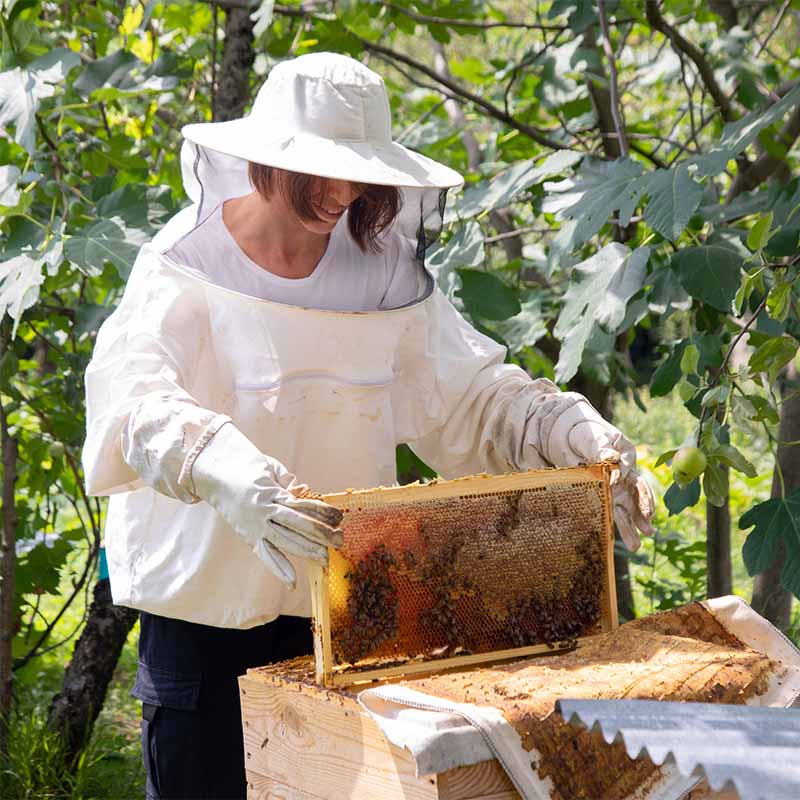


Addressing gaps in women’s productivity or only one of the domains of gender inequality – which are discussed in chapters 2 and 3 – is insufficient to achieve a meaningful and lasting change towards gender equality and women’s empowerment in agrifood systems. Over the past ten years, increasing attention has been placed on the importance of addressing structural constraints created by discriminatory social norms and gender-blind policies and laws in agrifood systems. This has led to increased urgency in designing projects aimed at increasing women’s empowerment and in measuring the impact of interventions in terms of both agency and empowerment. Business as usual is not enough: gender-transformative approaches are needed to address the broader socioeconomic context where gender equality and women’s empowerment occur, including the constraints that affect the engagement and aspirations of women and girls in agrifood systems.1
The gendered agrifood-system framework presented in Chapter 1 identifies four domains of gender inequality that act as constraints to women’s empowerment. These are 1) women’s agency, 2) gendered social norms, 3) policies and governance and 4) access to and control over resources. The four domains vary in the extent to which they are formal or informal and whether they constrain women at the individual or system level. Agency, norms, policies and access to resources interact and are affected by intersecting axes of social differentiation, discrimination and exclusion. Given their interdependence, benefits of improving one domain are contingent on achieving change in the other three areas. Chapter 3 covered access to assets and control over resources. This chapter looks at the first three domains.
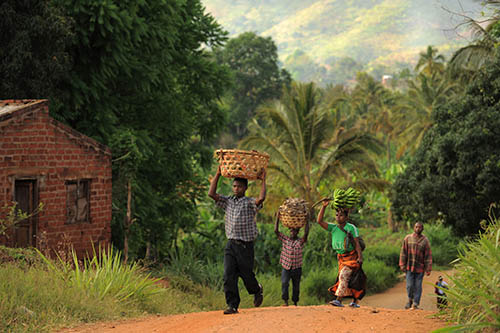


Addressing gender equality and women’s empowerment means dealing with constraining social norms and rigid gender roles affecting how women participate in agrifood systems. To do this effectively, men, boys and community leaders must all be engaged in the gender-transformative process. While there is much evidence of the importance of doing so, and of success at project or community level, it is difficult to identify large-scale societal improvements in the extent to which social norms have improved to facilitate gender equality and women’s empowerment. In contrast, a growing number of policies in an increasing number of countries are designed to be inclusive of women and girls. However, the extent to which they make gender equality and women’s empowerment an explicit objective, and therefore have a clear path for implementation, is still much less evident.
Empowerment is “the process by which those who have been denied the ability to make strategic life choices acquire such an ability.”2 This implies a transformation or change over time.3 Empowering men and women translates into improved well-being for all. It can also bring short- and long-term economic and social benefits for families, communities and nations at large. Empowerment is central to the global development agenda and is reflected in multiple targets for SDG 5: Achieve gender equality and empower all women and girls. It is also a critical element in gender-transformative change in agrifood systems.
Empowerment was not a major consideration in The State of Food and Agriculture 2010–11,4 when attention on gender gaps focused more on inequalities in terms of access to resources and achievements. Since then, however, women’s empowerment has become an explicit objective of agriculture and food systems interventions aimed at increasing agricultural productivity or household nutrition, 5 allowing for a more holistic view of achieving equality in agrifood systems.
Empowerment focuses on increasing an individual’s ability to make choices and their ability to exercise choice. It incorporates three interrelated domains: 1) resources (access and future claims to material and human resources), 2) achievements (outcomes related to well-being) and 3) agency (decision-making). Agency is the ability of people to identify their goals, make choices and then act upon them and can take multiple forms, such as bargaining, negotiation or resistance.2 Women can exercise agency in many ways, including as individuals, collectively, within the family and through their participation in markets, politics and other formal and informal networks.
In the context of agrifood systems, agency is frequently measured as women’s self-reported ability to participate in intrahousehold decision-making (for example, the use of agricultural land or household income) as a proxy for their bargaining power.6 Having a voice in intrahousehold decisions can be a meaningful dimension of empowerment because it may be desirable in itself and can also determine resource allocation within the household.7 From an agrifood-system perspective, agency also allows women to play a stronger role in the governance of value chains, avoiding their exclusion from strategic negotiations and actions that facilitate greater access to markets. Given the centrality of agency for women’s empowerment, indexes such as the Women’s Empowerment in Agriculture Index (WEAI) family of tools (see Box 4.1) have strongly centered their measurements on agency.8
Increasing women’s empowerment is challenging given its complex, intangible and political nature. Measurement of women’s empowerment and gender equality is important for four main reasons.i It can support better project designs, and shed light on how interventions can lead to unintended adverse effects, such as GBV. Measurements and assessments of empowerment can build also accountability and credibility in projects and policies which seek to enhance it,ii and finally, can challenge power relations by including participants in decisions on what, how, when and who should measure empowerment.iii
The stronger focus on empowerment in literature related to gender equality has increased interest in measuring changes to empowerment. The WEAI, which captures women’s agency and empowerment in the agriculture sector, was launched in 2012.iv, v Prior to the WEAI, there was no metric that focused exclusively on measuring women’s agency in this sector.vi It includes ten indicators across five equally weighted domains: 1) Decisions about agricultural production; 2) Access to and decision-making power about productive resources; 3) Control over use of income; 4) Leadership in the community; and 5) Time allocation.
The WEAI has several advantages. First, it captures both women’s and men’s absolute levels of empowerment in agriculture and women’s achievements relative to men within the same household. Second, the index captures access to productive capital and financial services, group membership and time use and thus incorporates a more holistic perspective of agency than indicators that measure only participation in decision-making. Third, the decomposable nature of the index allows users to track progress on the different dimensions of empowerment, including assessing complementarities and trade-offs among indicators.
The WEAI has led to a number of adaptations which include the abbreviated WEAI and the project-level WEAI (pro-WEAI), developed as a metric to measure the impact of agricultural development projects on women’s empowerment and diagnose areas of disempowerment.vii The pro-WEAI looks at intrinsic, instrumental and collective agency. Intrinsic agency, or power within, reflects a person’s internal voice, self-respect or self-confidence; instrumental agency, or power to, captures a person’s ability to make decisions in their own best interest; and collective agency, or power with, is the power individuals get from acting together with others (see Figure A).
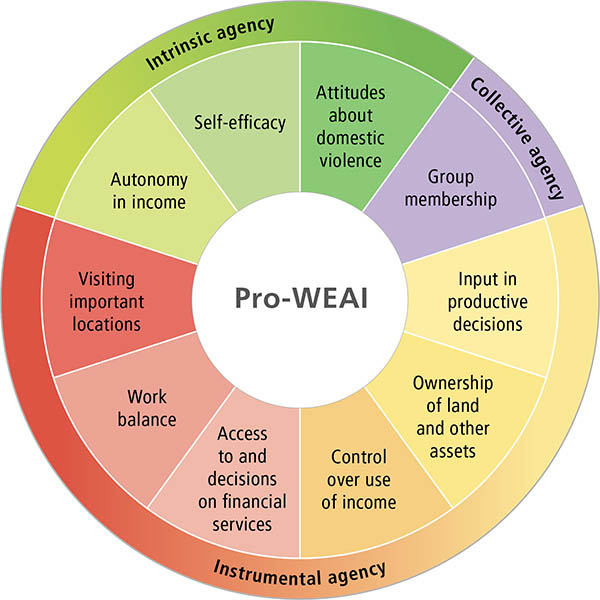
The pro-WEAI also includes optional add-on modules for livestock and health and nutrition for projects that are interested in assessing empowerment along those dimensions.i There are also stand-alone adaptations measuring livestock,viii fisheries,ix market inclusion and nutritional outcomes.x, xi The WEAI and its variants have been widely used (Figure B).xii
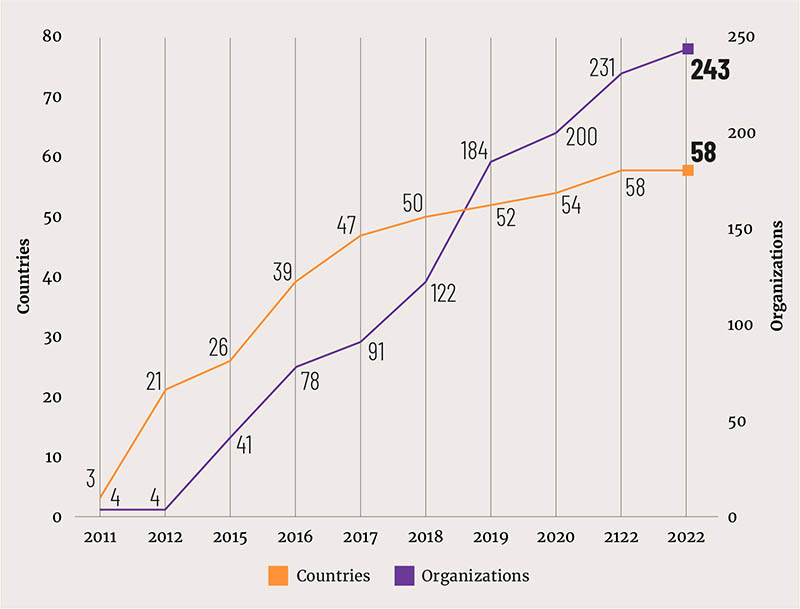
While the WEAI and other derived tools have helped to standardize and compare impacts on women’s empowerment, they also have several notable shortcomings. First, the multivariate nature of the index means that overall changes in empowerment are conditioned by trade-offs, for example, between women’s increased participation in household and farm activities which can be empowering, and increased work and time burdens which are not. Second, while it is useful to measure aspects of decision-making about incomes and assets, it is hard to judge whether changes to empowerment also lead to improvements in women’s well-being unless the measures are coupled with more standard impact variables that provide a measure of increases to incomes and assets, particularly among poor and extremely poor people. Third, even within the relatively standardized context of the WEAI, the use of different measures of outcomes within each domain of empowerment further complicates the ability to compare evidence across studies.
Increased interest in women’s empowerment as an objective of development interventions and the subsequent advances in defining and measuring empowerment have resulted in new insights into what helps to increase empowerment in the context of agrifood systems. Interventions in agrifood systems can be harnessed for women’s empowerment, but intentional design is needed to improve results. More is said about this in Chapter 6, which provides insights from what has worked and sets out a way forward for gender equality and women’s empowerment in agrifood systems.
Women’s instrumental agency – for example, control over income and assets or decisions over financial services – appears to be easier to influence, increase and measure than intrinsic agency and other elements of empowerment. In a review of a portfolio of 13 agricultural development projects from nine countries in Africa and South Asia that included combinations of crops, livestock and nutrition interventions and aimed at increasing income and nutritional outcomes, the pro-WEAI indicated that the programme impacts on empowerment were mixed.9 One-third of interventions led to a statically significant increase in household gender parity, one intervention reduced parity and the others had no statistically significant impact (Figure 4.1).
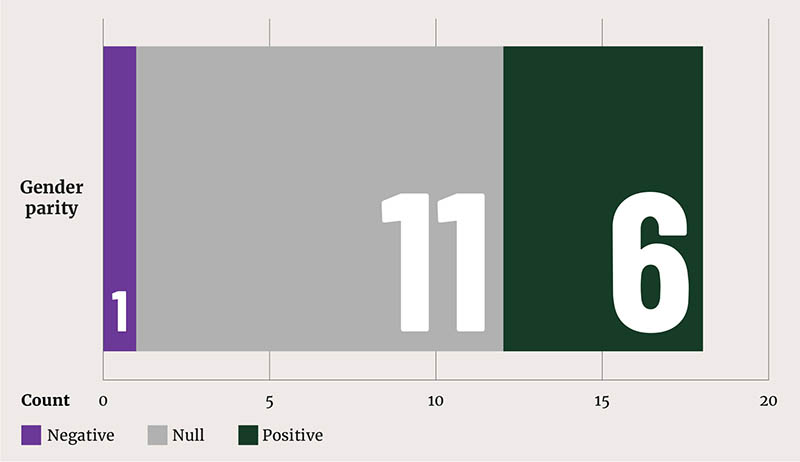
Additionally, most of the projects had no significant impacts on aggregate measures of empowerment. Men’s and particularly women’s empowerment increased in a number of projects, but not in the majority of projects (Figure 4.2).
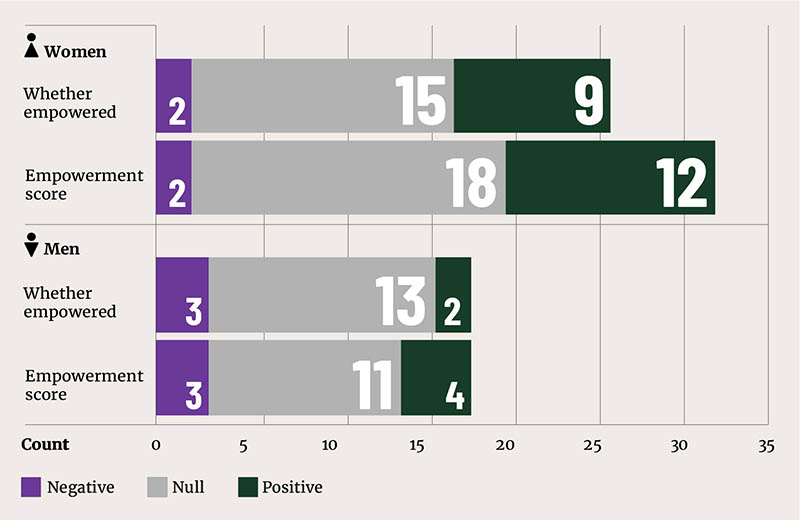
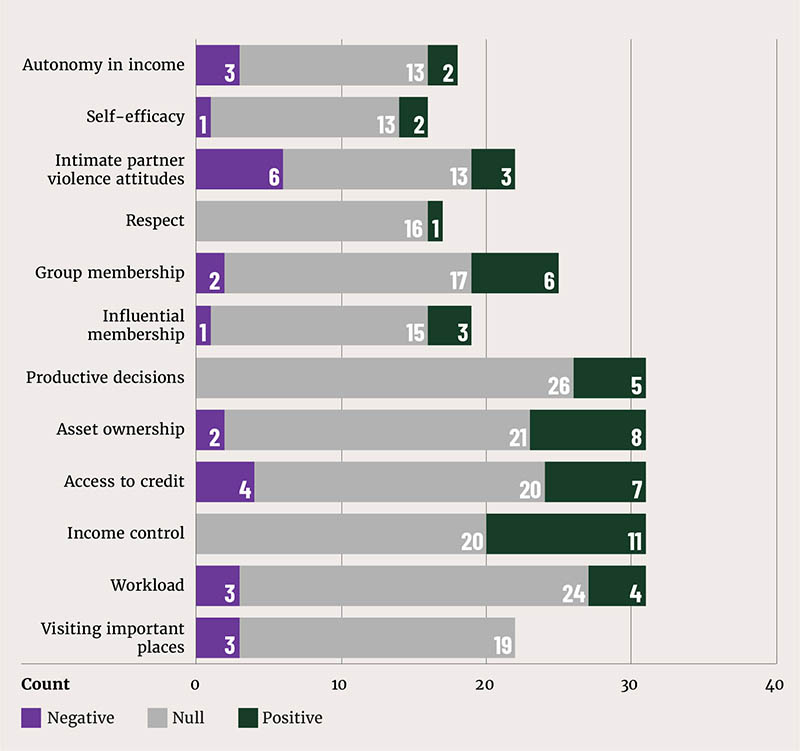
For women, most positive impacts on instrumental agency came from increased control over income, asset ownership and access to credit (Figure 4.3). Several projects found positive impacts on collective agency indicators, such as group membership, for women by using group-based approaches.
These results are not dissimilar to those from other large studies of the impact of interventions on empowerment. An evaluation of selected projects included in the Joint Programme on Accelerating Progress towards Rural Women’s Economic Empowerment (JP RWEE),10 which encompasses an approach focused on increasing food and nutrition security, income, leadership and participation and influencing a more responsive policy environment for gender equality and women’s empowerment, found mixed results on empowerment. The degree to which empowerment significantly improved for both women and men depended on the country, context and programme implementation, with more positive results reported in Kyrgyzstan, more negative results reported in Ethiopia and a mix in Nepal and the Niger (Table 4.1).
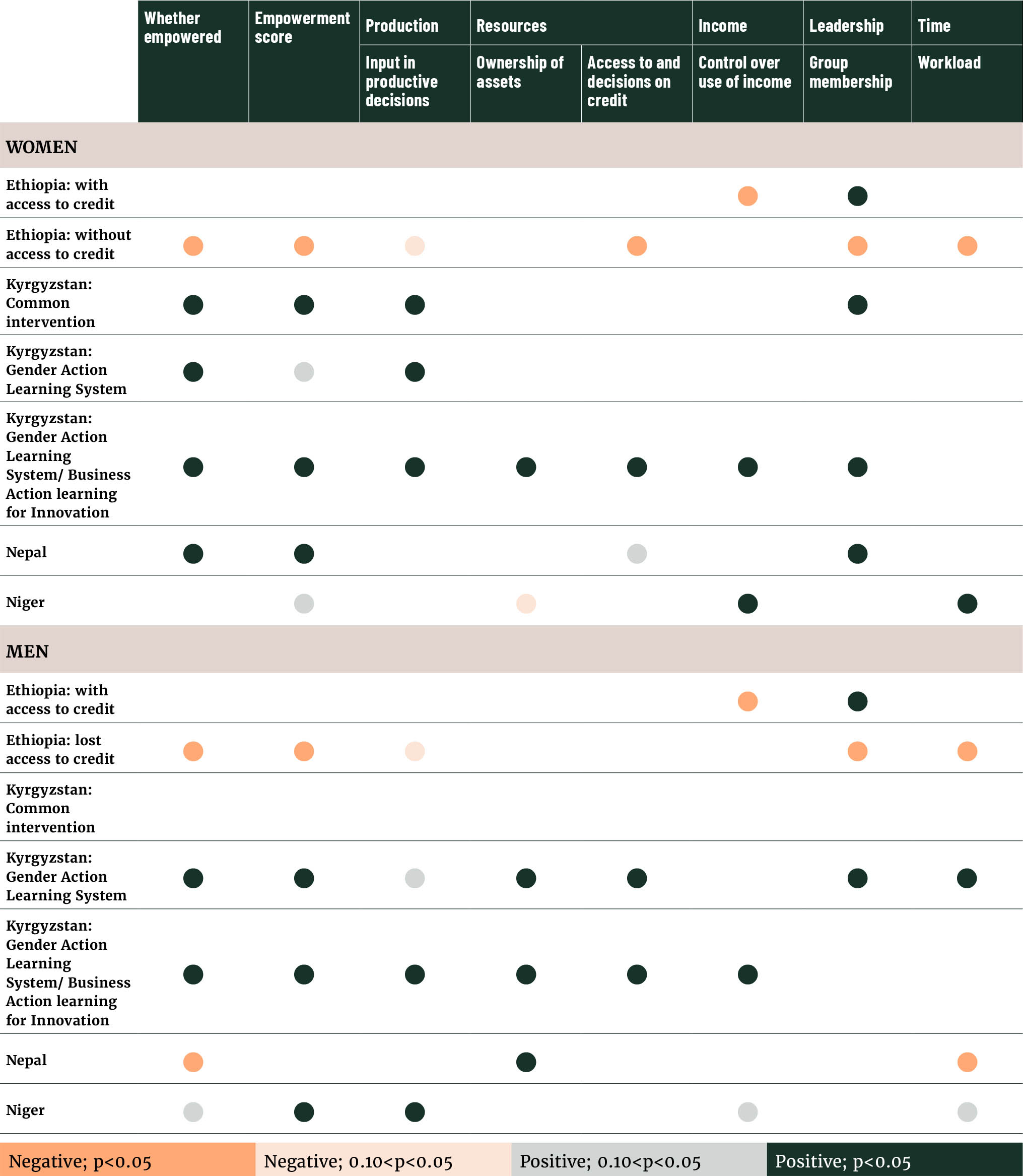
The livestock sector has key entry points to support women’s empowerment (see Chapters 2 and 3 for a discussion of the gendered patterns of participation in the livestock sector and livestock ownership). A review of 106 studies of livestock interventions and their impact on women’s empowerment found that extension, training and education had the highest proportion of positive impacts, followed by asset transfers (Figure 4.4).11 However, all types of livestock interventions had more negative than positive impacts on both women’s and men’s workload. Other studies shed light on the need for local context to understand how gender dynamics and norms interact with interventions to affect women’s empowerment.3, 12, 13
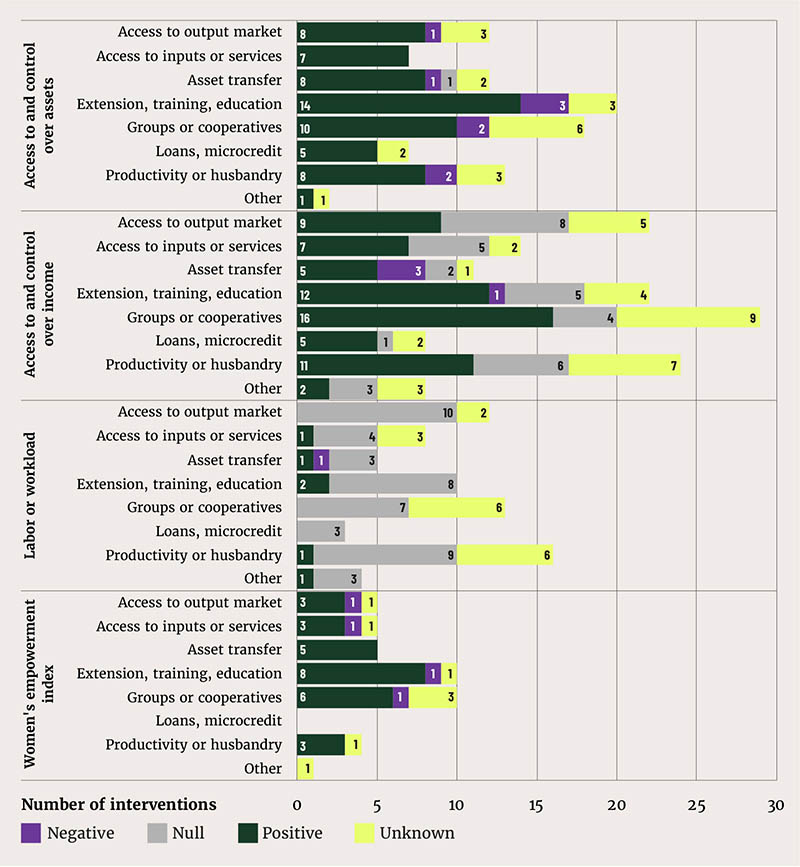
A systematically positive impact on women’s empowerment is difficult to achieve because women often face multiple disadvantages and because programmes often tend to tackle only some of the constraints. Even increased assets and incomes for women do not automatically translate into increasing women’s opportunities to make strategic choices about their lives. However, positive relationships can be found between empowerment and a variety of development outcomes. Women’s empowerment improves household diets and children’s nutrition and increases agricultural production and household food security (Table 4.2). However, there is less evidence that it influences life satisfaction, educational outcomes and water, sanitation and hygiene.
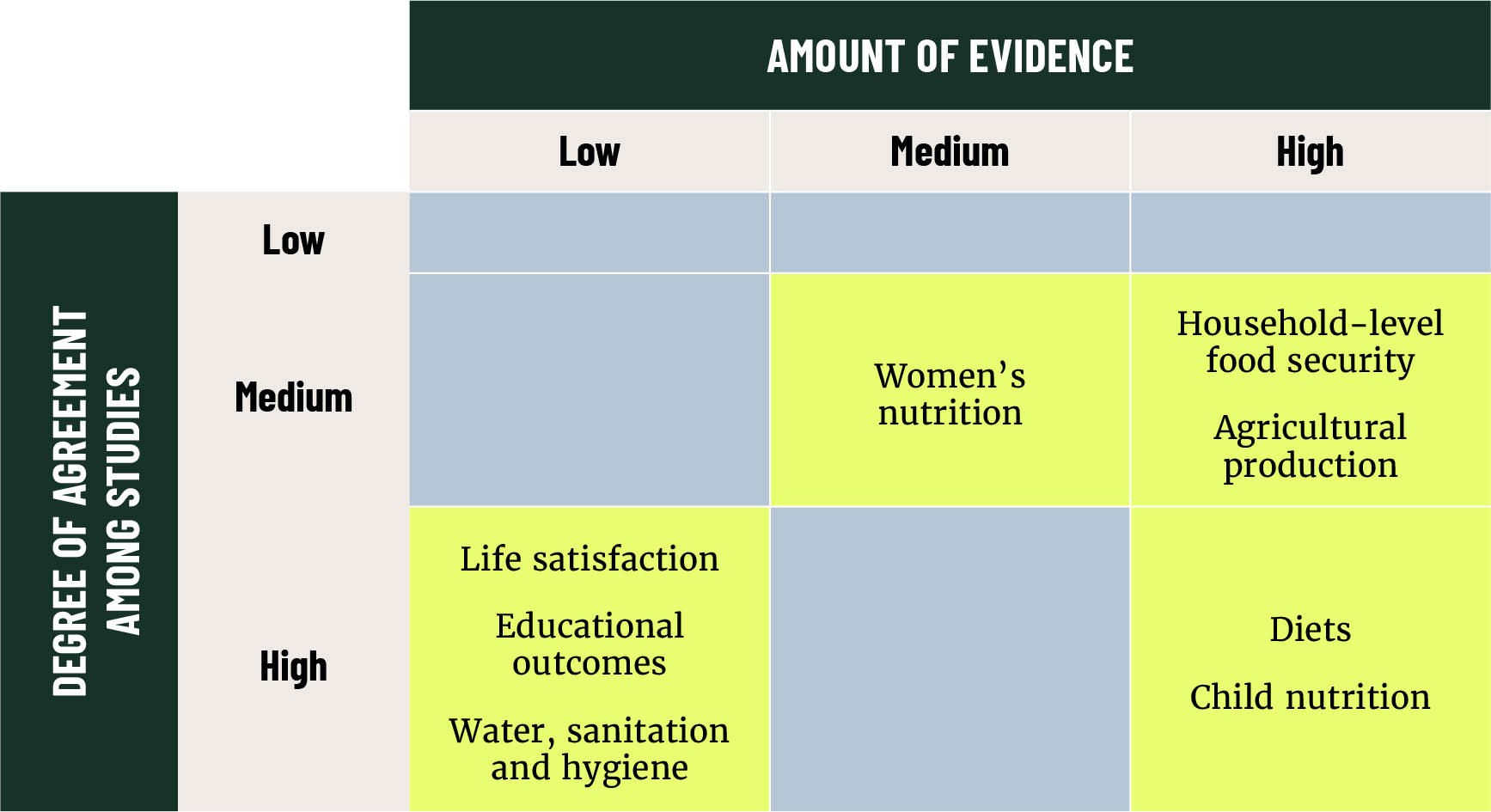
Child diets and nutrition: Many studies that use WEAI metrics document significant positive links between women’s empowerment and children’s dietary or nutritional status (Annex 2, Annex Table 2.1).3, 14 Women’s empowerment was positively linked to child dietary diversity score across most countries, age groups and by child gender.15, 16 There are also positive associations between the WEAI gender parity score and height-for-age z-scores and exclusive breastfeeding in several contexts (Bangladesh, Cambodia, Ghana, and Nepal), but less frequently, with child dietary diversity score (Bangladesh).3, 15, 17, 18, 19, 20
Adult diets and nutrition: There are few studies that look at the relationship between women’s empowerment and their own diets and nutrition; evidence from those that do is inconclusive.3 WEAI studies indicate a need to assess aggregated and disaggregated measures to unpack the link in this relationship (Annex 2, Annex Table 2.2). While some studies show positive relationships between women’s aggregate empowerment score and dietary diversity scores,3 components of the index indicate potential trade-offs in these relationships. For example, in a six-country study greater intrahousehold equality, more autonomy in production and higher workload were associated with lower body mass index (BMI), while increases in speaking in public and satisfaction with leisure were associated with higher BMI.21, 22
There are also differences according to the specific context. For example, positive correlations were found between women’s empowerment score and dietary diversity in Bangladesh, Ghana, Kenya, Mozambique, Rwanda and Timor-Leste but no significant effects were observed in Malawi, Uganda or Zambia.18, 23, 24, 25 A review of gender equity in income, land and livestock, and workload found no studies that reported women’s nutritional status or diet quality as outcomes.26
Two studies from Bangladesh assessed the relationship between women’s empowerment and men’s nutrition and diets (Annex 2, Annex Table 2.3). Increases in women’s access to and decisions on credit and group membership were related to lower BMI for men in one study,27 while in the other, increases in women’s empowerment score, rights over assets and group membership were related to higher dietary diversity scores for men.18
Household diets and food security: There is limited evidence on women’s agency and household food availability and access, and the results vary by context. In Bangladesh, higher levels of women’s empowerment were correlated with better household dietary diversity and per capita calorie availability (Annex 2, Annex Table 2.4) 27, 28 while in South Africa, women’s access to and decisions on credit were negatively related to dietary diversity.29 The relationship between women’s empowerment and food security also varies with the type of agricultural product, decision taken and indicator of empowerment.30 There are also inconclusive findings between intrahousehold gender equality and various measures of household food security and diets, although higher-quality studies indicate more consistent positive findings.26 In Bangladesh, for example, gender inequality within the household was marginally associated with lower household dietary diversity scores among non-poor, time-poor and income- and time-poor households, though not households that were only income poor.31
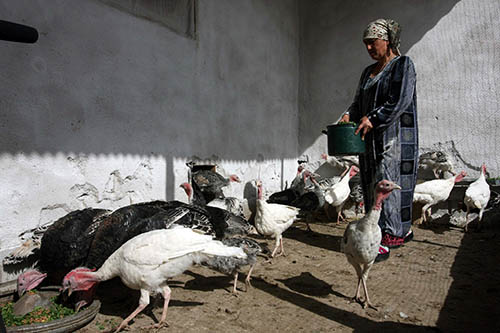


Gains to agricultural productivity: Relatively few studies assess the relationship between women’s empowerment and productivity gains in agriculture but some report positive links that vary by outcome. Empowerment has been shown to have a positive impact on agricultural productivity in Bangladesh and the Niger and among maize farmers in Kenya.32, 33, 34 In the Niger, it was estimated that a one percent increase in empowerment would raise agricultural output by almost one percent.34 In Bangladesh, an increase in women’s input into farming decision-making led to an increased allocation of land to fruits and vegetables and a reduction in land allocated to cereals.35 Greater intrahousehold gender parity has also been shown to be positively correlated with production efficiency in Bangladesh. 32, 36
Other domains: Less evidence exists on the relationship between women’s empowerment and other well-being outcomes such as schooling, life satisfaction and mental health. Increases in women’s and men’s life satisfaction were positively correlated with empowerment score and several WEAI indicators in Bangladesh.37 The study found that women and men benefited from different domains of empowerment. For instance, having input in decisions had a larger impact on men’s lives than women’s. However, borrowing had a negative impact on women's life satisfaction but no impact on men’s, indicating that women may feel more stress from additional responsibilities of having to pay back loans. In another study in Bangladesh, father’s empowerment was positively associated with younger children’s schooling, while mother’s empowerment was more important for girls’ education and for keeping older boys and girls in school.38 Increasing women’s empowerment has also been linked to decreased stress and postpartum depression in Burkina Faso.39 Other empowerment indicators, including women’s freedom of movement and group membership, have also been noted to be indicative of reduction in poor mental health and well-being in studies in India and Senegal.40, 41
Few studies assess the relationship between women’s empowerment and productivity gains in agriculture.
Informal social norms and practices, as well as formalized policies and institutions, can create barriers to women’s empowerment and socioeconomic well-being. Addressing these barriers is critical to building agrifood systems in which women can fully participate and exercise their agency. Achieving gender equality, women’s empowerment and other lasting changes in agrifood systems depends on building enabling policy and legal frameworks and removing or addressing the underlying constraints to women’s ability to access complementary resources and feel empowered.1, 42 It also depends on reducing existing informal restraints related to discriminatory social norms that prevent women from realizing their aspiration.8 Norms have a material impact on the extent to which women can access services and can also shape formal regulations.43
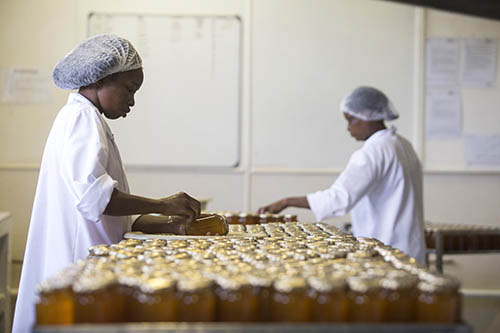


Discriminatory social norms in agrifood systems create power imbalances between men and women and limit the choices that are available for them. Shaped by belief systems, they define what is typical and appropriate behaviour for men and women, for each community or context. These often result in women being more involved in unpaid care and domestic work, having restrictions placed on their mobility and options for non-domestic work and market activities, and limitation in their access to and control over assets and income.44 These normative limitations can create constraints for women’s economic participation in agrifood systems (for example, as sellers, employers or employees) and affect their ability to access and benefit from technologies, services and social networks (such as rural organizations and agricultural trainings).45, 46, 47 They can also affect women’s aspirations (see Box 4.2).
Low aspirations are internal constraints that may undermine individuals’ beliefs in their capabilities; as such, they can hinder agency and empowerment,i, ii economic behavioursiii and political and community participation.iv
Men and women in farming communities and in the broader agrifood systems may have different aspirations with respect to work, education, incomes and social status; these may vary by context and generation. Across developing countries, young people often aspire to leave agriculture and to have a blue- or while-collar job.v, vi But when they are unlikely to obtain the needed education, young men express an interest in “modern” agriculture, whereas young women express no such interest as persistent negative norms and resource constraints limit their opportunities in agriculture.v
Gendered patterns of aspirations change with the transformation of rural areas.vii In rapidly transforming rural areas in Morocco, for example, young men aspire to modernized farming and to engage in agri-entrepreneurship while young women try to balance their aspirations between traditional gender roles (marriage and motherhood) and a desire for independent income.vii In areas with significant male outmigration and insufficient lucrative off-farm livelihood options, such as parts of Kenya, women farmers reported to aspire to commercialize their farms.viii
Diverse formal and informal institutions, including social norms, shape individuals’ aspirations.9 Individuals’ aspirations are also influenced by the lives and achievements of role models in the family, in the community and beyond the community.ix Female leaders are important positive role models for girls and women, particularly in rural communities. Exposure to female leaders in a nationwide experiment in India raised aspirations of young women, closed the gender education gap and reduced the time girls’ spent on household chores.x Exposure to female leaders in Lesotho led to more egalitarian attitudes among girls even though it did not change the levels of public gender biases,xi and female role models positively influenced young girls’ labour choices and decreased their tolerance for gender stereotypes.vi
The level of gender-based discrimination in social institutions (legal, cultural and traditional practices discriminating against women and girls) varies by region and country but remains unacceptably high globally (Figure 4.5).48 Discriminatory norms related to other social categories such as ethnicity, religion, age or disability intersect with gender norms, further constraining options available to certain population groups.48 Discriminatory norms around girls’ value in society intersect with poverty and food insecurity to create drivers of child marriage.49 Norms harmful to both men and women, such as the stereotype of the male breadwinner, also contribute to stress among male farmers that may lead to suicide when men feel they cannot provide for their families.50, 51, 52, 53
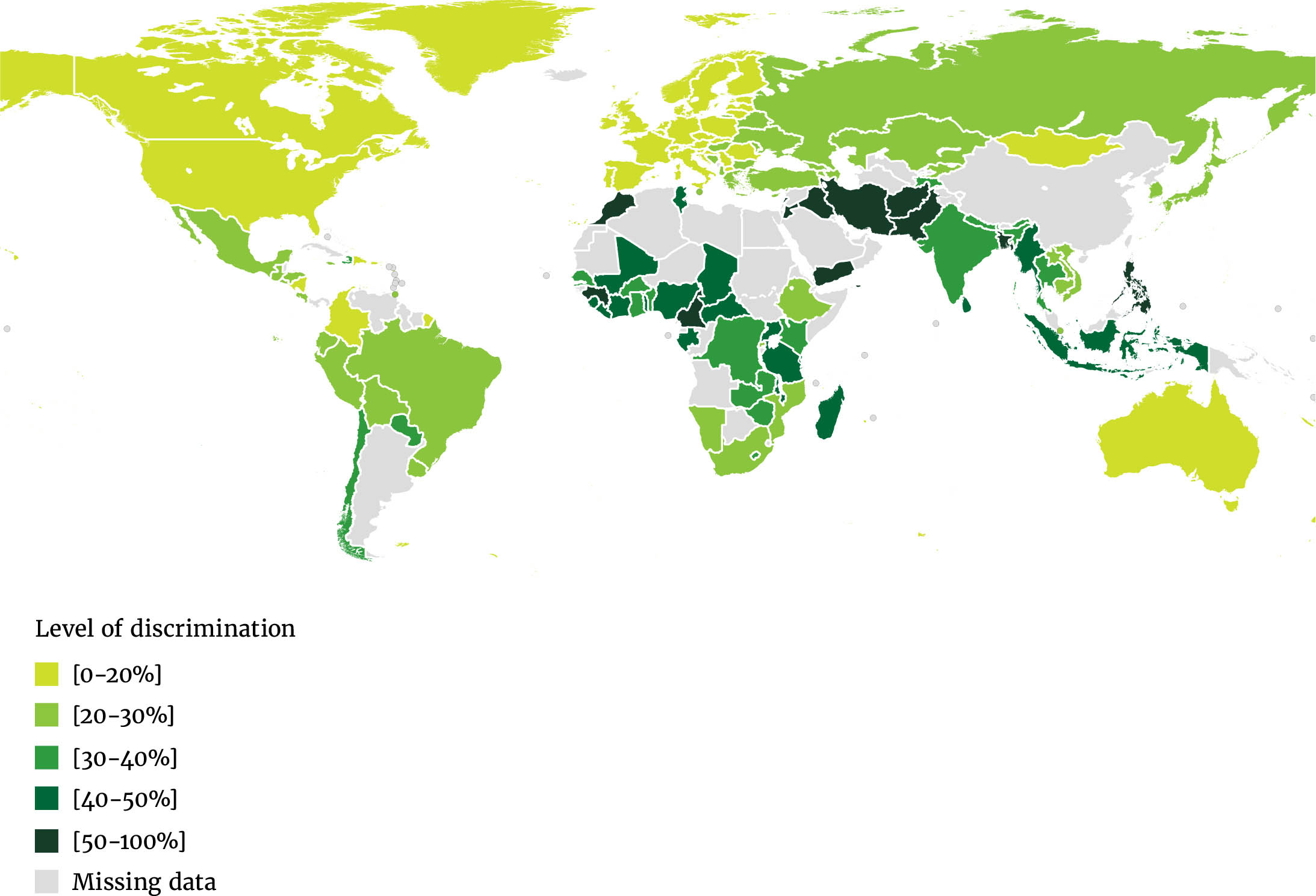
Social norms about gender and women’s work remain strongly constraining in communities of Asia and sub-Saharan Africa where the most people work in primary production in either agriculture or fisheries,54, 55 and in lower- and middle-income countries more broadly.56 This situation also constrains women’s access to and use of technology in farming, which in turn limits their productivity and earning potential.45, 57, 58 There are exceptions, however. In parts of Kenya, for example, women are increasing their access to agricultural services and farmer groups. This is linked to perceived new roles for women in the household as primary recipients of training in new practices, despite their time constraints.54 In some areas of Asia, norms have relaxed in ways that allow for women to have more active roles in fisheries and commercial farming, which has helped make their mobility more acceptable.47, 55
Globally, the acceptance of different social norms varies across nations, with slow improvement over time. For example, wide regional variation is evident in norms relating to gender-based violence (specifically, whether wife-beating should be tolerated, see Figure 4.6). In Latin America, it is rarely supported, while in sub-Saharan African countries it is more broadly tolerated. Tolerance of wife-beating modestly declined in most countries between 2006–2013 and 2013–2019.
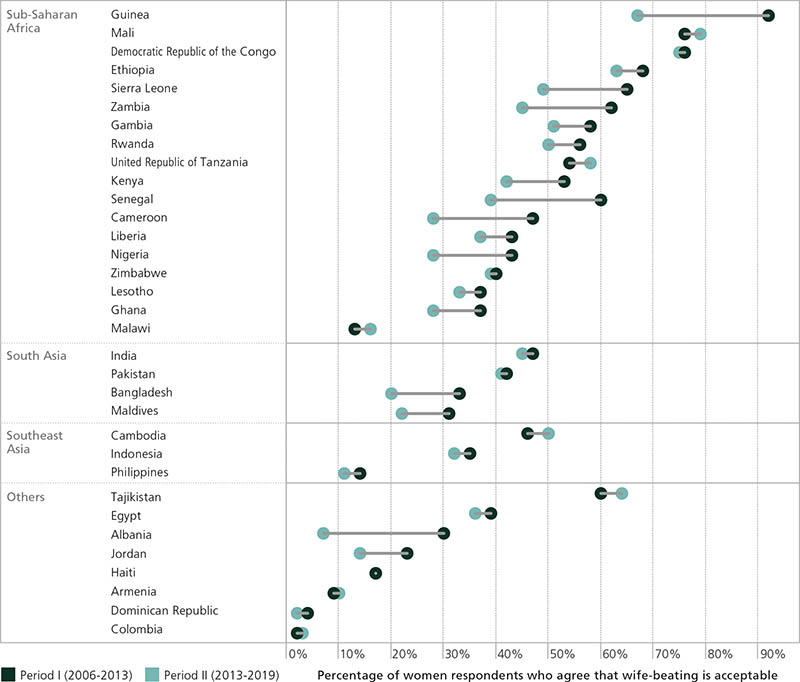
In line with the constraining norms described above, it is widely believed globally that mothers should look after young children instead of engaging in paid work. In many countries across all regions, more than 50 percent of respondents believe that young children suffer when mothers work (Figure 4.7). This social norm is consistent with the widely held belief that men should have preferential access to jobs during times of crisis or downturns.59, 60, 61
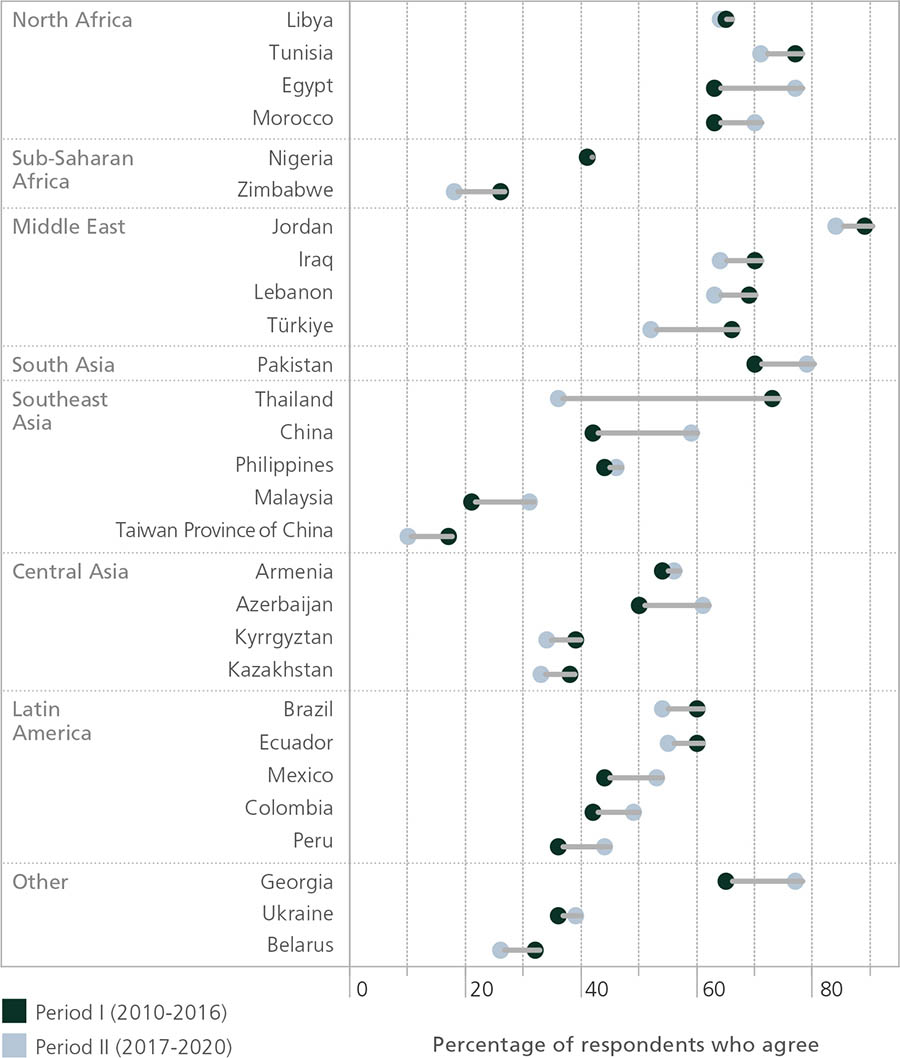
On the other hand, a majority of respondents in both North and sub-Saharan African countries support women’s rights to own and inherit land (Figure 4.8).61, 62 More than 50 percent of respondents in all but three countries believed that women should have the same rights as men to own and inherit land.
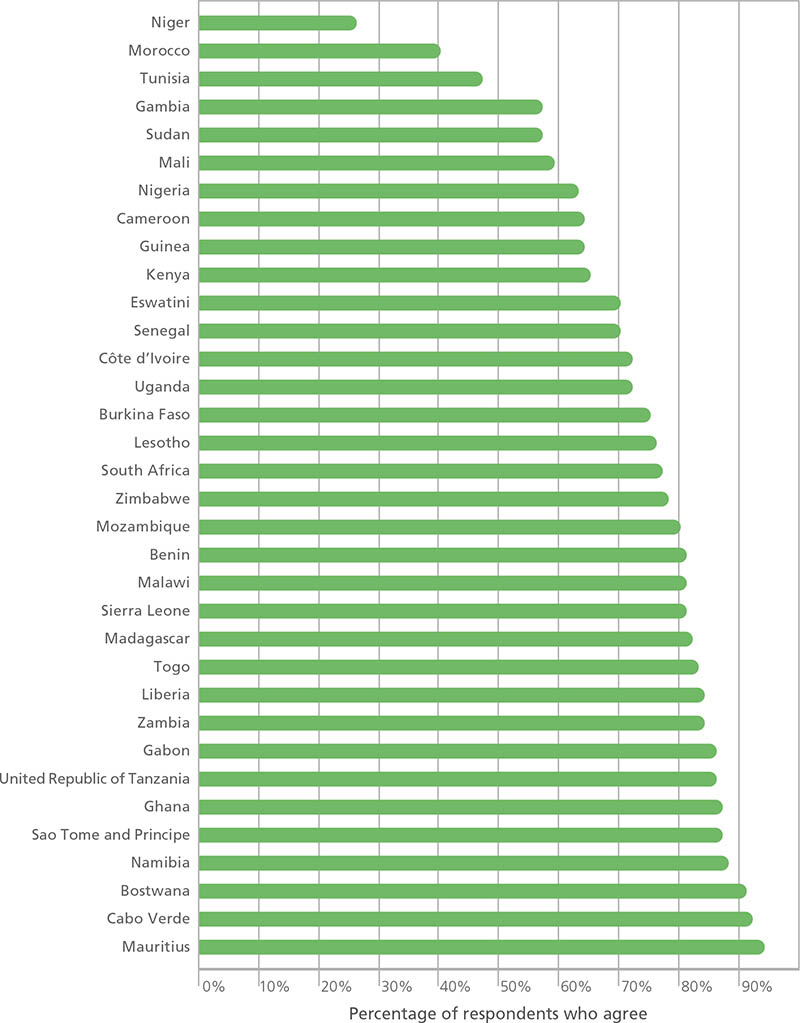
Gender inequality in agrifood systems has persisted in part because policies and institutions continue to constrain equal opportunities, returns to labour and rights to resources, despite the fact that more attention is being paid to the gender gaps highlighted in Chapter 3.63 Changes are needed across a broad set of policies, including fiscal policies; policies incentivizing investment, research and innovation; and policies related to social sectors such as education and nutrition.64
The extent to which national policy frameworks address gender issues has improved over the past decade. National policies and budgets in East Africa and Latin America have increasingly highlighted structural gaps in access and included efforts to produce gender-responsive outcomes.65, 66, 67 An index measuring legal differences between men’s and women’s access to economic opportunities in 190 economies shows improvement across all low- and middle-income regions.68, 69 These improvements are most notable in South Asia and the Near East and North Africa, both of which started from a lower level and still score significantly lower than other regions (Figure 4.9). Laws in sub-Saharan Africa about mobility, assets and entrepreneurship have improved the most vis-à-vis all other regions during the period 2011-2022. In Burkina Faso, Sierra Leone and Zambia, scores assigned to laws that support entrepreneurship improved by 33 percent during this period.
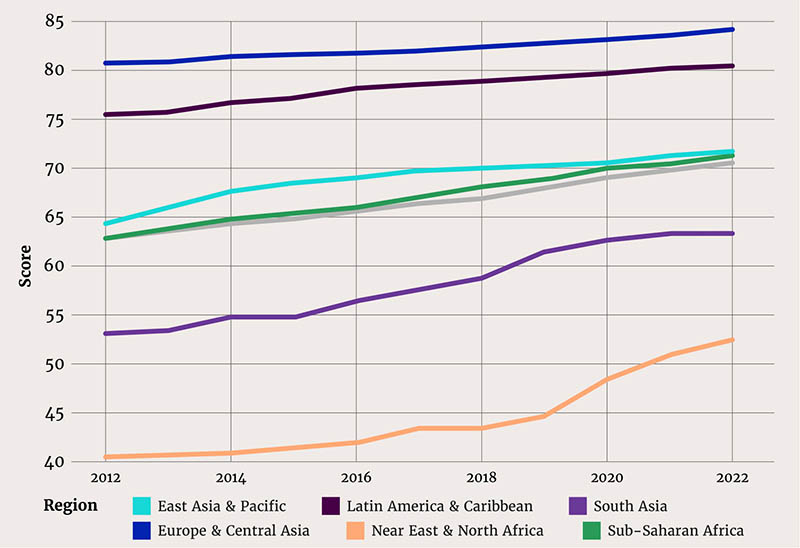
Additionally, the Convention on the Elimination of All Forms of Discrimination Against Women has been ratified by all African countries, and 42 African countries have ratified the Protocol to the African Charter on Human and Peoples’ Rights on the Rights of Women in Africa (the Maputo Protocol).48 Positive progress was also made in enacting laws and reforms to address gender-based violence and for increasing women’s rights to access credit and land.48, 70, 71
In agricultural policies: The extent to which agricultural policies address gender equality and women’s empowerment varies. An analysis of agricultural policy documents (e.g. national agricultural policies and national agricultural development plans) from 68 low- and middle-income countries using FAO’s Gender in Agricultural Policy Assessment Tool (GaPO)72 showed that 15 percent of documents were gender blind (i.e. no mention of gender in/equality or women’s empowerment) (Level 1, Figure 4.10), while most included some consideration of gender. However, 43 percent of policy documents included only very few and/or very generic measures to promote gender equality (Level 3, Figure 4.10). Only one document explicitly proposed gender-transformative measures to address discriminatory social norms (Level 5, Figure 4.10). Sub-Saharan Africa is a leading region in the gender-responsiveness of their national agricultural policies, followed by Latin America and the Caribbean (Figure 4.10).
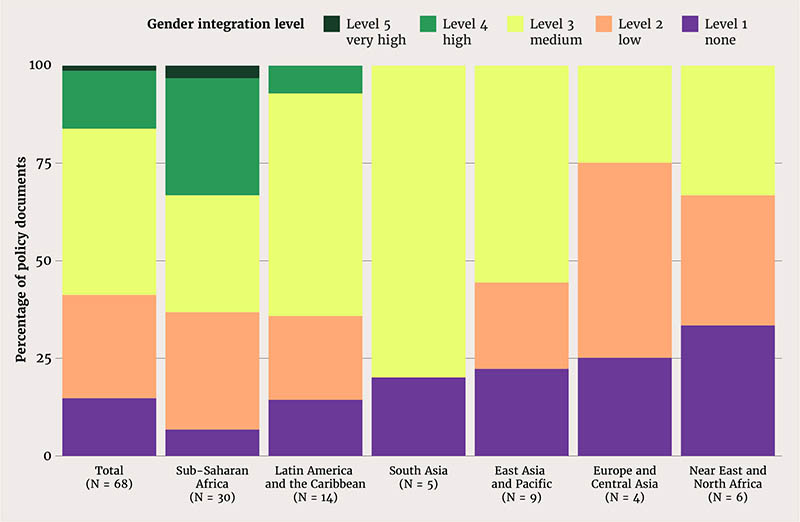
Few of these policies fully address gender equality and women’s empowerment issues. While more than 75 percent recognized women’s roles and/or challenges in agriculture, only 19 percent had gender equality in agriculture and/or women’s rights as explicit policy objectives, 29 percent supported the use of sex-disaggregated data for policy monitoring and evaluation and only 13 percent encouraged rural women’s participation in the policy cycle (Figure 4.11). About 80 percent of policies did not consider discriminatory social norms, gender-based violence or other intersecting vulnerabilities such as climate change.
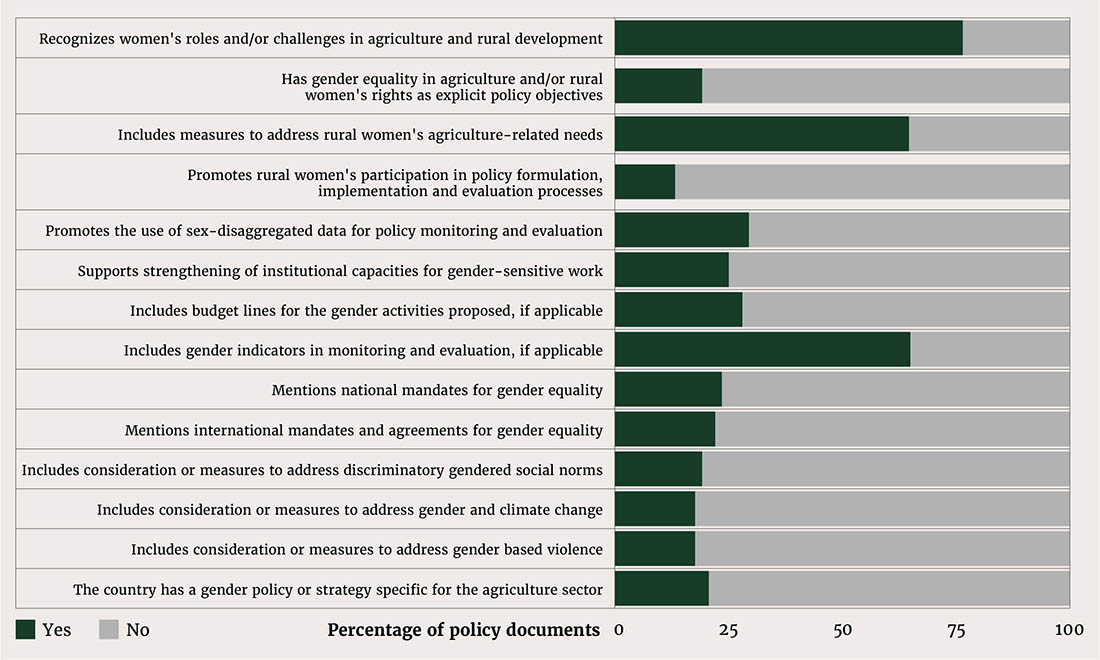
Climate policies: Overall, a modest improvement was made over the past decade in the degree and way in which gender equality and women’s rights issues are introduced in climate-related policy, with a progressive increase in international financing of gender-sensitive interventions and in women’s representation in international climate change fora and negotiations. Heightened attention to gender and climate change in policy is also reflected in a recent review of nationally determined contribution (NDC), where the percentage of reviewed NDCs with mentions of women and/or gender increased from 40 percent in 2016 (intended NDCs) to 78 percent in 2021 (updated NDCs).73 Agriculture was the sector with the greatest degree of integration of gender (33 percent) and sub-Saharan Africa and Latin America and the Caribbean were the regions with the highest rates of gender inclusion in their NDCs: 94 percent (17 out of 18 NDCs) and 100 percent (18 out of 18 NDCs), respectively.73
However, evidence from Central America, East Africa and Nepal indicates that integration of gender equality and women’s rights issues in national climate and agriculture policy is often superficial, with passing mention of “gender,” often merely acknowledging its relation to climate change.74, 75, 76 Gender integration in climate and agriculture policy has also often portrayed women as largely vulnerable and passive victims of climate change,76, 77, 78, 79, 80 although there is evidence that this is changing: the number of NDCs that consider women as “stakeholder” and “agents of change” has increased over the period 2016-2021, signaling progress in portraying women as active participants in climate action.73
Despite these positive changes, national agricultural and environmental policies that mention gender-related vulnerabilities to climate change often still do not include policy measures or strategies to address them during implementation.76, 81 A study from Zambia highlights that, while overarching national policies and development plans present clear provisions for gender mainstreaming, natural resource management and climate change programmes lack sound monitoring and evaluation mechanisms to track progress in implementing gender provisions.82
The mismatch between the policy discourse and policy action on gender and climate change is also evident in budget analysis. In Nepal the national budget allocated to climate change action makes no reference to gender despite recent increases in the allocation.76 Parliamentarians and policymakers commonly lack the knowledge and capacity to integrate gender and intersectionality in climate change policy and action.83, 84 This is often exacerbated by barriers to effective implementation, including the lack of political will and highly gendered social institutions through which gender and climate-related policies are supposed to be enacted.74, 75, 82, 85, 86
Limited data are available with regards to the integration of gender, agriculture and climate change in subnational development policy. In Uganda gender and climate change discourse progressively declines when moving from national to district and subnational level policies.81 An analysis of the extent to which gender is budgeted for in implementation plans at district and lower governance levels in Uganda and the United Republic of Tanzania found a sharp difference between estimated and actual allocated budgets, with the latter remaining consistently low.74 Similarly, in Uganda limited amounts were allocated to gender equality issues in subnational development plan budgets, with the limited amounts allocated to broad categories such as “women,” “gender” and “women’s affairs”.81
Higher levels of female political representation in national parliaments leads to more stringent climate change policies.87 However, women and women’s organizations are commonly marginalized in climate decision-making processes in governance at both national and local levels.88, 89, 90 Women’s inclusion and participation in international climate decision-making policy processes also remains limited, although recent evidence points to a gradual improvement. For example, the percentage of women delegates on national delegations to the United Nations Framework Convention on Climate Change (UNFCCC) increased from 30 percent in 2009 to 38 percent in 2021, although only 13 percent of heads of delegation in 2021 were women (up from 10 percent in 2009).91 Activism by women’s organizations has also been influential in international climate policy decision-making processes, playing a key role in, for example, the establishment of the Women and Gender Constituency at the UNFCCC Convention of the Parties.90, 92